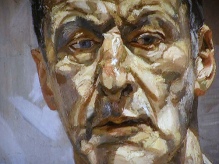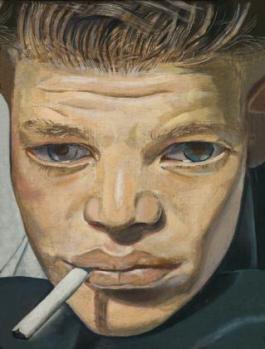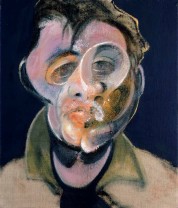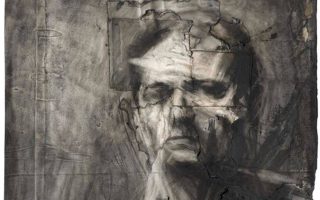My favorite portrait artist is Lucian Freud whose portraits are not particularly realistic but somehow they get to the truth or the essence of the sitter. Of course I have no knowledge of what sort of people his sitters were and so I can’t say this categorically but his work suggests something more than superficial appearances. Lucian Freud’s portraits and nudes have a raw quality about them, literally like raw meat and they say a lot about Freud because he hardly ever painted commissions and only painted people he felt attracted to. I think the grossness of some of his paintings says something about his views on the temporary nature of our bodies and how we are all decaying flesh.
Lucian Freud’s portraits and nudes have a raw quality about them, literally like raw meat and they say a lot about Freud because he hardly ever painted commissions and only painted people he felt attracted to. I think the grossness of some of his paintings says something about his views on the temporary nature of our bodies and how we are all decaying flesh.  I also like the fact that he associates with the criminal classes, was a very heavy gambler and has an affection for people who can only be described as ‘characters’; his portrait called ‘Boy Smoking’ (1951) was of a lad he caught trying to break into his studio, he also likes dogs with many appearing in his paintings which suggests he finds their unconditional affection, straightforwardness and tactility, refreshing compared to humans, it suggests a vulnerability enclosed in a worldly protective exterior. His contrary nature, which has a dark subversive edge to it is manifested in his work by the way it never looks too much like serious art and this is a conscious attempt to avoid being part of the art world, whilst at the same time he of course knew all the famous artists and sold paintings for millions of pounds (admittedly the funds passed swiftly to his bookmaker). Freud consistently painted self portraits throughout his career and so there’s a range of examples of his work spanning his early life right up until his death.
I also like the fact that he associates with the criminal classes, was a very heavy gambler and has an affection for people who can only be described as ‘characters’; his portrait called ‘Boy Smoking’ (1951) was of a lad he caught trying to break into his studio, he also likes dogs with many appearing in his paintings which suggests he finds their unconditional affection, straightforwardness and tactility, refreshing compared to humans, it suggests a vulnerability enclosed in a worldly protective exterior. His contrary nature, which has a dark subversive edge to it is manifested in his work by the way it never looks too much like serious art and this is a conscious attempt to avoid being part of the art world, whilst at the same time he of course knew all the famous artists and sold paintings for millions of pounds (admittedly the funds passed swiftly to his bookmaker). Freud consistently painted self portraits throughout his career and so there’s a range of examples of his work spanning his early life right up until his death.
What is interesting is how different his approach is in many cases; sometimes he blocks in large areas with more livid colours and sometimes there is more detail but the intensity of his observation is evident, sometimes the surface is smooth and sometimes it is more textured. He was presumably painting self portraits for his own satisfaction or was it to practice new techniques, or was it to mark the passage of decay in his own body? It is interesting to compare his work to two of his contemporaries (and friends) who both paint in completely different styles, Francis Bacon and Frank Auerbach.  Francis Bacon’s portraits could almost be pictures of wounded WW1 soldiers who are half way through a process of facial reconstruction and the effect is just as visceral, it’s the distortion of the features that is somehow repulsive but compelling at the same time.
Francis Bacon’s portraits could almost be pictures of wounded WW1 soldiers who are half way through a process of facial reconstruction and the effect is just as visceral, it’s the distortion of the features that is somehow repulsive but compelling at the same time.  Frank Auerbach on the other hand draws portraits in charcoal on paper, rubbing out and redrawing until the paper is often destroyed and has to be patched. He has drawn only a handful of sitters in his career and mentally rehearses possibilities in his mind every time he draws until he reaches a point where he feels the work exists as a ‘thing’ in it’s own right rather than as a visual representation of the sitter. Another favorite portrait artist is Stanley Spencer who again didn’t paint portraits for commission but painted self portraits at various times of his life and also portraits of those closest to him. His works have a child like quality although the draftsmanship is anything but child like, they are often physically and also emotionally intimate and I sense a reverence in the way he paints.
Frank Auerbach on the other hand draws portraits in charcoal on paper, rubbing out and redrawing until the paper is often destroyed and has to be patched. He has drawn only a handful of sitters in his career and mentally rehearses possibilities in his mind every time he draws until he reaches a point where he feels the work exists as a ‘thing’ in it’s own right rather than as a visual representation of the sitter. Another favorite portrait artist is Stanley Spencer who again didn’t paint portraits for commission but painted self portraits at various times of his life and also portraits of those closest to him. His works have a child like quality although the draftsmanship is anything but child like, they are often physically and also emotionally intimate and I sense a reverence in the way he paints.

I like the playful portraits and self portraits of David Hockney and the self portraits of Tracey Emin which are drawn in a casual, autobiographical way, like a crude snapshot of a moment in time, they are often subversive in that they question perceptions of what Art is thought to be. Many of her self portraits have words which refer to her life such as an abortion she had or unfulfilling relationships or indeed her beloved Margate where she grew up.
They are often sad but sometimes funny and the spirit of her personality is something that comes through and makes you want to know her more. She says of the words in her works, “When it comes to words I have a uniqueness that I find almost impossible in art- and it’s my words that actually make my art quite unique”. When she was appointed professor of Drawing at the Royal Academy there were populist comments in the press voicing criticism of the decision :
‘Uproar at the Royal Academy as Tracey Emin is made Professor of Drawing’
(Daily Mail 14th December 2011)
A closer analysis of some of her work reveals a freedom and expressiveness in her brush mark making that is as good as any of Cezanne’s watercolours, so I think she is probably exactly the sort of Professor of Drawing the Royal Academy’ needs .
I have always found the portraits of Botticelli appealing as the faces of his women seem to be so contemporary somehow and yet they were nearly always painted for a patron or to flatter a nobleman or woman, I think they say a lot about notions of what beauty was in the Renaissance and they also show how wealthy the subjects were with the lavishness of their dress and jewelry, their fair skin also shows that they didn’t need to work.
Not every portrait artist commissioned to paint a portrait gets it right; most famously Graham Sutherland’s portrait of Winston Churchill was ultimately burned by his widow because Churchill thought it made him look like and idiot, however it’s probably more telling of Churchill’s more private personality than other portraits that flatter to deceive and is therefore more intriguing and valuable as an historical record, Sutherland probably did get it right after all.
Honesty is a factor in assessing a portrait. How honest was the artist when they produced the painting? Arguably one can say a self portrait is the most honest form of painting as the artist isn’t depending on the money from their client but we all lie to ourselves about ourselves and have a self image that isn’t necessarily how others see us. Perhaps the most childlike and honest self portraits are those by Van Gogh who only sold one painting in his entire life and what makes them even more informative is that we have Van Gogh’s comprehensive diaries and letters to his brother Theo to compare to the paintings, some of which are described by Van Gogh in the diaries. In letter to Theo 249 dated 21st July 1882 while he was in the Hague painting peasants and agricultural scenes he wrote,
“Whether in figures or in landscapes, I would like to express not something sentimentally melancholic but deep sorrow. In short, I want to reach the point where people say of my work, that man feels deeply and that man feels subtly. Despite my so-called coarseness — you understand — perhaps precisely because of it”
This was early in his life and it’s sad that this should be so prophetic when considering his career as a whole and in particular the period at Arles and his suicide. It’s also worth noting how he associated with the peasants and talks of his own coarseness as this was something he often chose to portray in his self portraits. However the collection of images below shows many different self portrayals so which one is the real Van Gogh? Probably all of them.





















